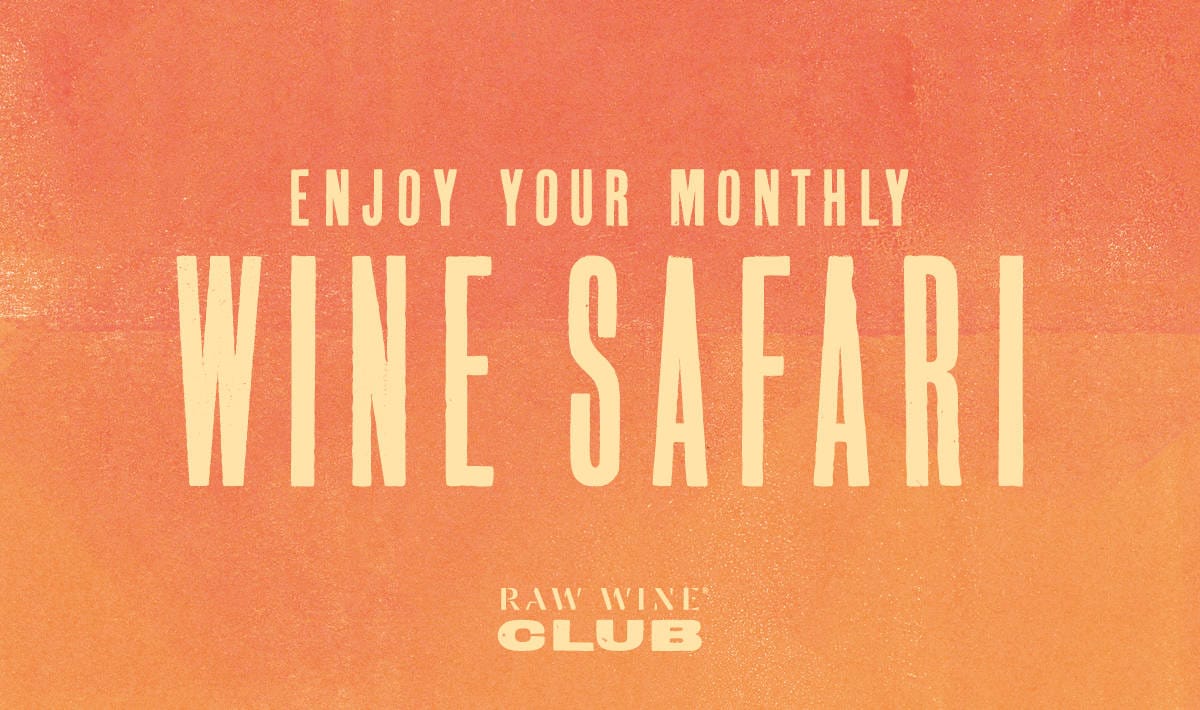
RAW WINE Club - Tasting Notes - March 2024 Selection
39 min read
Spring is nigh and as the weather starts hopping around, so too are the bottles in this month’s selection. Whether you are sitting in dappled sunlight or still wearing winter woolies, you’ll find something to suit. There’s a highly drinkable pet nat (by none other than Patrick Bouju) from the Volcanic Auvergne in central France; a deliciously unusual, pure Macabeu from the foothills of the French Pyrenees (perfect as an aperitif); an accomplished, skin-contact Muscat with depth and complexity, from the hills of Chile’s Itata Valley; a textbook Cabernet Franc with a twist; a delicious, chillable red made in a cowskin; and a spicey, full-bodied, comfort-food of a wine from Alicante in Spain.
As ever, enjoy!
Warmest wishes,
Isabelle Legeron MW, Founder of RAW WINE
---
Domaine La Boheme, 'Festejar!' Rosé Pet Nat, Auvergne, France, 2022
Domaine La Boheme is a winery in Saint-Georges-sur-Allier, in France's Auvergne region. It's run by legendary natural winemaker Patrick Bouju and partner Justine Loiseau, who manage 9 hectares and buy grapes from other growers to make their wine.
Q&A with Patrick Bouju & Justine Loiseau
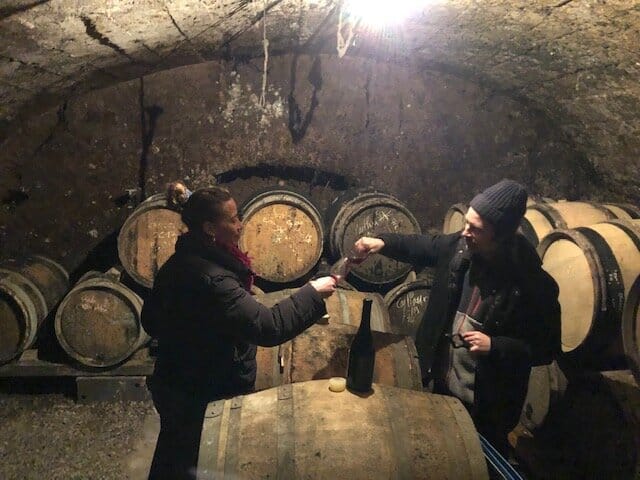
Patrick, can you tell me about your background in chemistry and the military, and how you came to be a winemaker?
Patrick: I didn't start making wine until 1997 - I had studied organic chemistry in Clermont-Ferrand and didn't want to be a winemaker. It wasn't a passion at first. While I was studying, it was obligatory for all men to serve in the French military. Because of this, I had to go to Burgundy from 1995 to 1996. While I was there, I met a lot of winemakers and learned how to make chemical wine - very few people were making natural wine there at the time. But then I met Dominique Derain, who was working in this way. So I took what I had learned with me to Auvergne. I made a lot of vinegar in the beginning, but it was all a learning experience. I learned from makers in Auvergne and Beaujolais, but it wasn't like it is now - there weren't a lot of people you could learn from. People didn't want to buy natural wine either. The year I made my first cuvée, I couldn't live off the income, so I worked both in the vineyard and also for IBM. Then in 2004, I met some some Japanese people who started to import my wine over there. This was the first step to being able to make a living from wine.
And how about yourself Justine - what's your background and what was your entry point to wine?
Justine: I studied communications in Paris, where I grew up. My course was half school and half practical, so I worked three days a week. During the evenings, I worked in restaurants with my aunt in a very posh area of the city. I started to realise I didn't want to work in communications, but in restaurants. I started learning about classic wine, in classic restaurants. In 2012, my friend Jane Drotter opened a restaurant, Yard, and she introduced me to natural wine - along with Fleur Godart and Clovis Ochin. We started organising tastings at the restaurant and that's how I met Patrick. We've known each other for 10 years now and, at the beginning, I travelled back and forth between Paris and Auvergne. I visited a lot but was scared to move to the countryside because I had grown up in Paris and was used to that way of life. Then, I lost my job and my apartment, so I made the decision to go to Auvergne. I found it really interesting, hard of course - you make a lot of mistakes early on - but you get to be creative and now, we get to do it together. We are a good team.
Patrick, what stage were you at with the winery when Justine joined you?
Patrick: When I started making wine, I worked alone and made only a few bottles. I didn't want to grow too much - 3-4 hectares initially - because it would be too much to manage by myself. Later, I got an employee who helped me. Then I started to buy grapes because we had some issues in the vineyard which meant we lost a lot of grapes. When Justine came to live here, it was an opportunity to grow more grapes, produce more wine and develop. We are a good team - we work a lot like a lab. We have a lot of projects and Justine helps me realise my dreams. The life of a winemaker isn't just to grow grapes and make wine, you also have a lot of administration and logistics, and Justine manages this side of things. We come up with all of our ideas together.
What would you say has most influenced your approach to growing and producing?
Patrick: For me, I have a lot of allergies, so I can't drink with with sulphites. That's why it was really important to me to be able to make a wine that's completely natural. As I said, I didn't want to be a winemaker at first, but because I was drinking a lot of natural wine, I was heavily influenced by makers such as Gilles Azzoni, Claude Courtois, Domaine du Peyra, Guy Breton and Jean Maupertuis. And we're like family now. We always talk about wine.
Justine: My wine education originally came from my family, who had very classical tastes. My grandpa always drank white wine from Burgundy and red wine from Bordeaux. In 2012, when I met Clovis Ochin, he made me taste Jean-Yves Péron's Vers La Maison Rouge from Savoie and it blew my mind. I saw that you could have light wines with a lot of complexity, and opened my mind to what's possible.
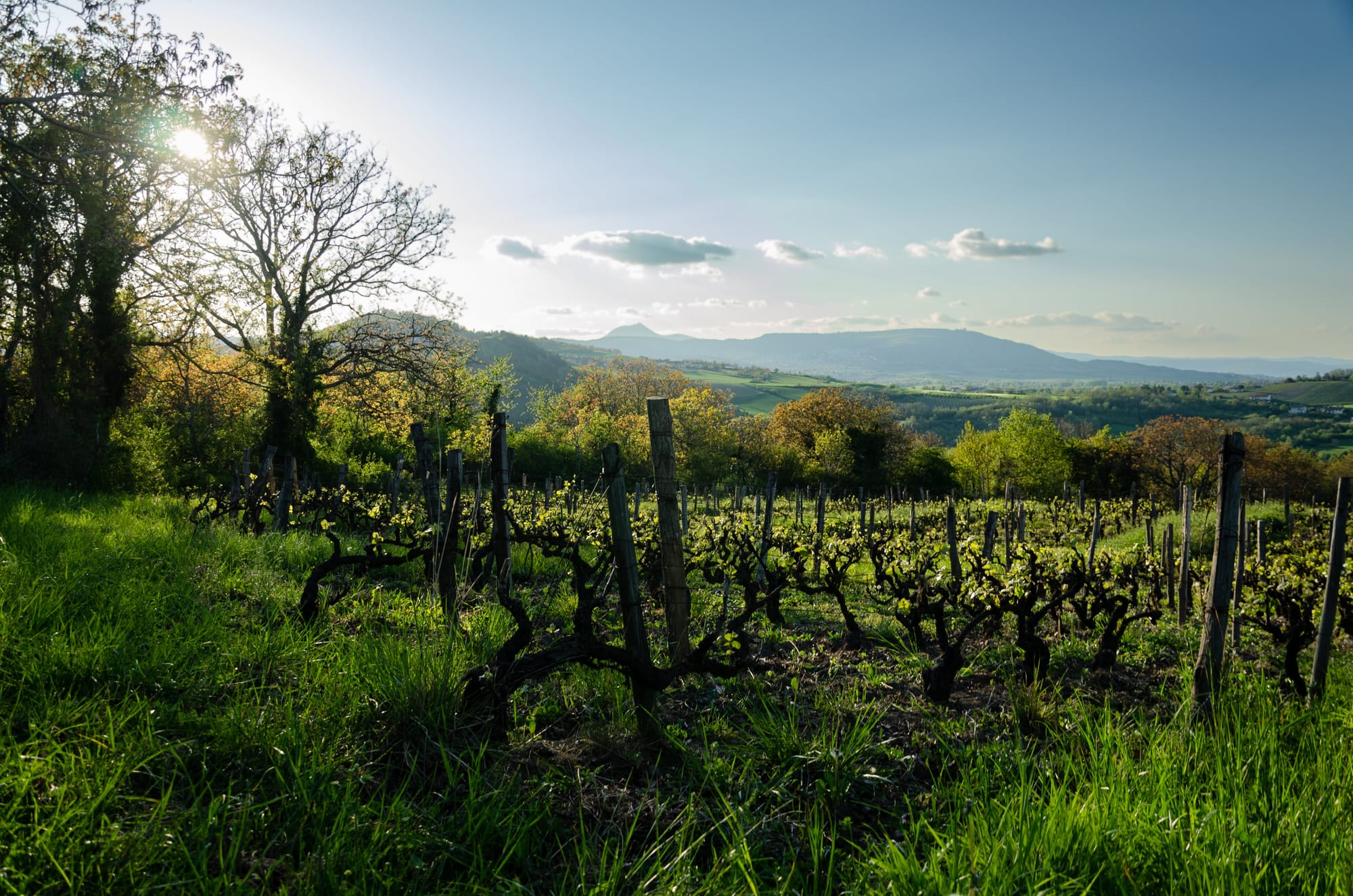
Can you tell me about Auvergne and the grapes, climate and traditions that define the region?
Patrick: At the beginning, Auvergne was not very famous. There's a mountain so the vineyard sits at 500m altitude. There's a lot of volcanic characteristics - a lot of basalt and limestone with volcanic influence in the soil. It's a very unique biodynamic terroir. The climate is very fresh, giving good acidity to the wine. The main variety you find here is Gamay d’Auvergne. For me it’s one of the best Gamays, as it has a more spicy flavour and is more rustic than Gamay Beaujolais. There's also a lot of old vineyards. People having been making wine for their own consumption for a long time, so there's a lot of vines over 100 years old. It's a very unique experience to work with these grapes.
What grapes do you grow and how many hectares do you work with now?
Patrick: Now, we have 9 hectares - 2 of Chardonnay, 2.5 of Pinot Noir and the rest is all Gamay d'Auvergne.
Which grapes have you used for this wine?
Patrick: We use the Gamay and Pinot Noir, both from Auvergne, and less than 10% of Merlot from Côtes de Blaye in Bordeaux.
Can you talk me through the process of making this wine?
Patrick: To make a sparkling wine, you need acidity, so these grapes are always the first harvest of the year. For Festejar rosé in particular, we don't want high alcohol - always between 10-11% - so that's another reason we pick earlier. The Pinot Noir is harvested first, then the Gamay and then the Merlot. The Merlot was to inject some sugar and fresh yeast. We always use fresh - it's like making bread with a levain starter. The Pinot Noir and Gamay are macerated for around a day, just for some colour and fruitiness, and the Merlot is direct pressed. Everything is in stainless steel.
To make a natural sparkling wine, we use only the sugar from the grapes. We don't add sugar, yeast or anything else to the wine. When there's 20-25g of sugar left, we bottle with a capsule. From harvesting to the first bottling, the process takes 1-2 months. Then, fermentation continues in the bottle for 5-6 months and as soon as it stops, we turn it upside down to disgorge it.
Do you use any sulfites and what are the total sulfites per liter?
Patrick: We don't use any sulfites, so the naturally occurring content is 8mg/L.
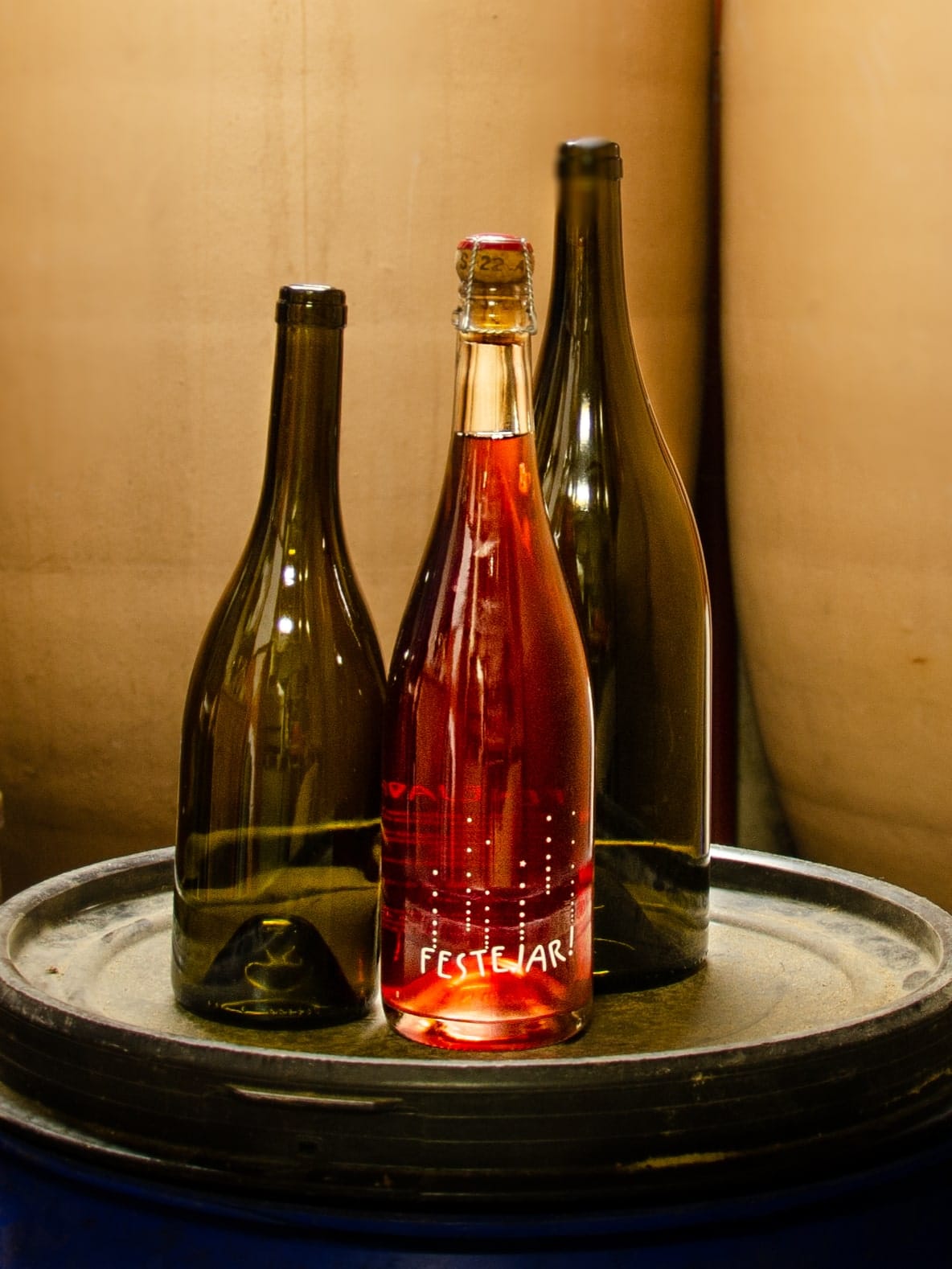
How would you describe the wine?
Patrick: We want to make a simple wine with a lot of fruit, that's easy to drink and can be enjoyed in spring and the summer. When I first started making this wine, it was sweeter, with a lot of raspberries and strawberries - better for drinking at night.
Justine: Now it's good to drink with dessert or even with breakfast if you have a hangover!
Patrick: It's very dry now. And it's not important to age this wine.
Justine: It's best to drink it on the fruity side in the first two years. It'll be good after this, but we want it to stay fresh, fruity and easy to drink. People not into natural wine will like it too. We want to make something that everyone can enjoy.
How does this vintage compare to others?
Justine: We try not to make the same wine every time, but with Festejar, we always want it to be fresh. 2021 was a good year for sparkling wine because it was cooler and therefore fresher. In 2022, it was warmer and harder, but we were able to still find that freshness and acidity by adjusting the blend of the grapes. We don't use complex recipes - we just think about the grapes we have. That's what's most important to us.
What’s the story behind the name of the wine Festejar, or party?
Patrick: Festejar means to celebrate, to party and to have fun in the medieval French language of Occitan. It has the same meaning in Portuguese.
Are there any dishes you've had Festejar with that you thought worked really well?
Justine: I definitely recommend having it with fruit - it's a good wine to pair with dessert or with a fruity cake. But it's also good as an aperitif, on its own or as a spritz with some bitters. You don't have to have it with food. It's a very easy wine.
What’s next for the Domaine?
Patrick: What we’re interested in now is planting new vines - of Gamay d'Auvergne, Pinot Noir and some other grapes, such as Sauvignon - and building a new cellar. We also want to develop the vineyards we buy from and find some good, different grapes. Why not in Burgundy, for example? Why not try vilifying different varieties?
Isabelle's thoughts on Festejar - This salmon pink, ancestral method wine from Gamay grown in the Auvergne, is made by the iconic Patrick Bouju and his partner Justine Loiseau. Festejar means ‘to party’ in the local dialect, a name brilliantly suited to this fun (almost glou glou), fruity drink. Showing notes of wild strawberry, sweet raspberry and cassis bud, it is ripe but also bone dry with a touch of the herbal about it and a subtle pepperiness that adds elegance. An easy drinking, pretty, juicy drop.
TOTAL SULFITES: 8mg/L
Domaine de l'Epeire, 'Astradyne' Côtes Catalanes White, Roussillon, France, 2022
Domaine de l'Epeire is a family winery with 6 hectares of vines on the slopes of the Roussillon, sitting at the foot of the Pyrenees and facing the Mediterranean sea. It's certified organic and is run by Philippe Petit, who practices biodynamic and low intervention viticulture.
Q&A with Philippe Petit
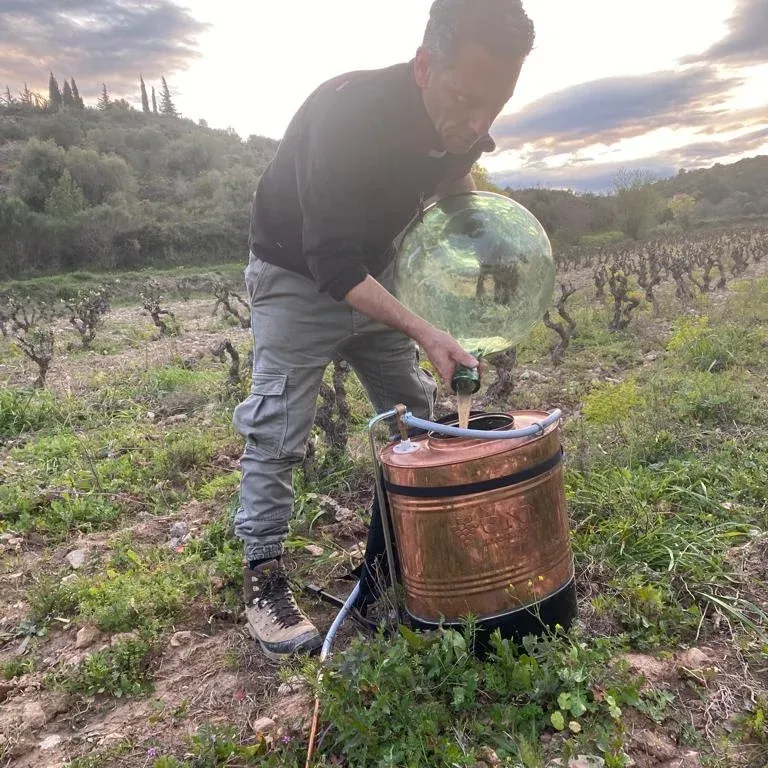
Can you tell me about your background - how you came to be a winemaker, and what influenced your style of farming and producing?
The vineyard I run was my paternal and maternal grandfathers' property and my parents lived here in the Roussillon as well, in a place called Calce. It's an old vineyard. I use organic and biodynamic farming practices and work in respect of my grandfather's principles, which were all about paying close attention to nature. I try to do my best to respect the family vines and history. I have several local grape varieties. One of them, which I use for this wine, is a local grape called Macabeo. You only find it here and in Catalonia.
I am at the end of the Pyrenean mountain range, in front of the Mediterranean sea at 100-200m high. The vines are spread across various small plots with different soils - clay, limestone, pebble and schist. They're all surrounded by garrigue, and local trees including kermes oak, olive, almond and juniper. It's a very dry place. We are concerned about the future because of this. Because we work with respect of nature, which can be challenging, we have to be very precise. I cultivated my vines for 20 years before starting my own winemaking, because I wanted to understand them. For me, what's most important is growing the grapes. If you do a good job in the vineyard, the winemaking is easier.
Can you tell me about where you are in Calce, and the grapes that define the region?
Calce is well known for having great winemakers in the village. We are based right at the beginning of the valley de l'Agly. It's 30km from the sea and the large mountains, which rise up to 2700m, are just 50km away. We are the southernmost point in France, just 50km from Spain and two hours from Barcelona. The main varieties I work with are Macabeo, and I make white with Grenache Blanc and Gris, and two kinds of Muscat, Petit Grain and Alexandria. This year I also started making orange wine with the Muscat grapes. For red wine, I have Carignan, Grenache Noir and Shiraz. I decided to make wines that are made by one vineyard plot, one grape variety and one soil in the souvenir of my grandfparent's heritage. Each parcel and each variety is on different soil. These grapes are all typical of the region. Shiraz was imported to this area maybe 50 years ago, but the others have always been here. My grandfather had them.
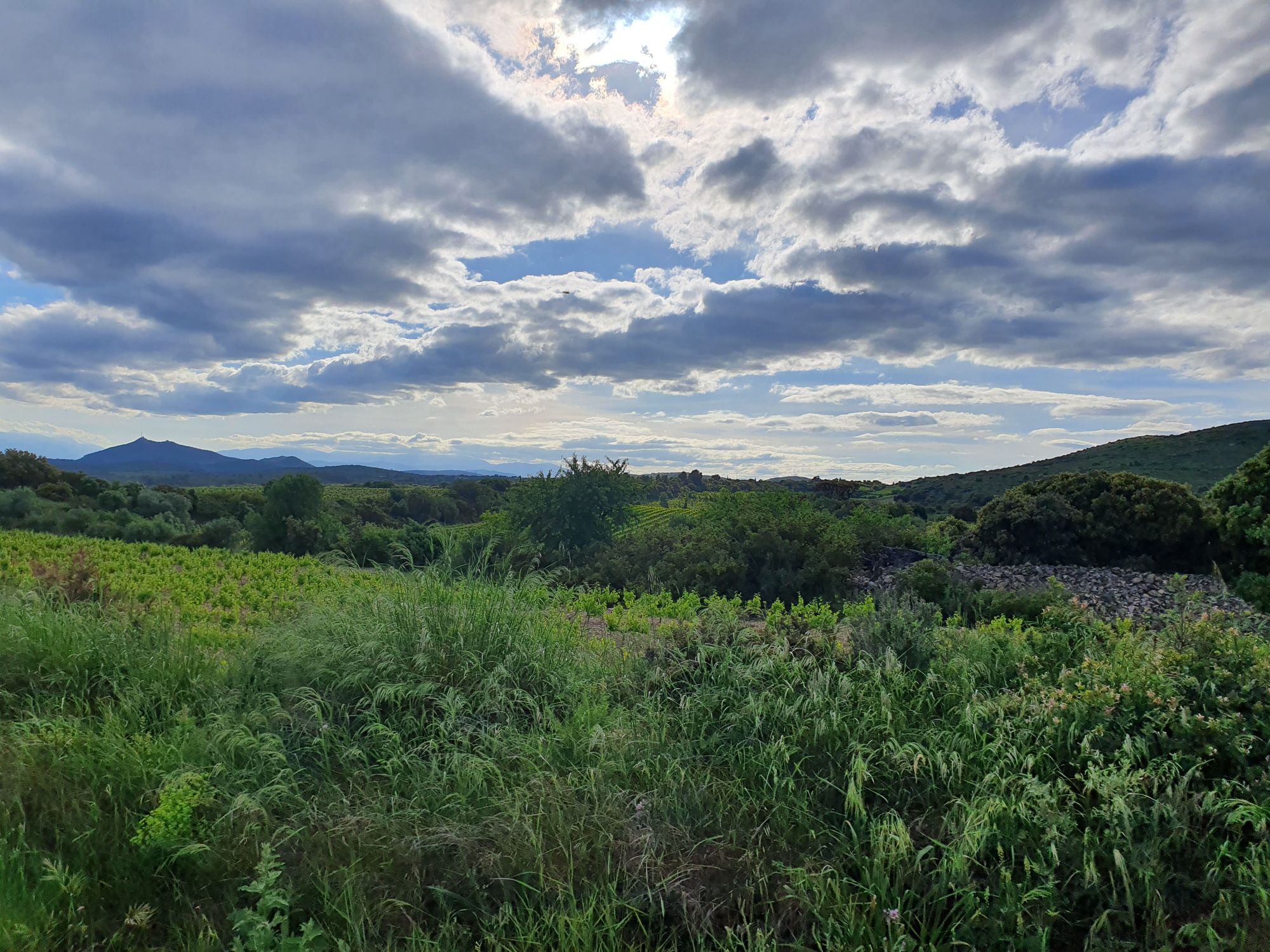
Is there much of a natural wine scene there?
It's one of the French hotspots for natural wine. We have a lot of winemakers here in the south of France. As it's dry, we don't get disease like mildew. The sun is always shining and there's a lot of wind, so it's very pure and easier to make natural wine. But with the dryness comes smaller yield - we produce 10-20 hectolitres per hectare.
How many hectares do you work with?
I have 6 hectares across more than 10 plots.
What's the soil for these Macabeo grapes?
It's clay limestone and rounded pebbles.
Can you talk me through the process of making this wine?
Astradyne is a wine with 100% Macabeo from 75 year old vines with a yield of 15 hectolitres per hectare. I harvest by hand at the beginning of August, which is early so that we can retain the tension and aromatics of the grapes. We harvest into little crates of 10kg and direct press in whole bunches. The juice goes into amphora and I keep it on fine lees and make batonnage for a month. It remains in the amphora until the end of spring. I work using indigenous yeasts and bottle unfined and unfiltered, with a small quantity of sulfites - but only at bottling, not during the vinification.
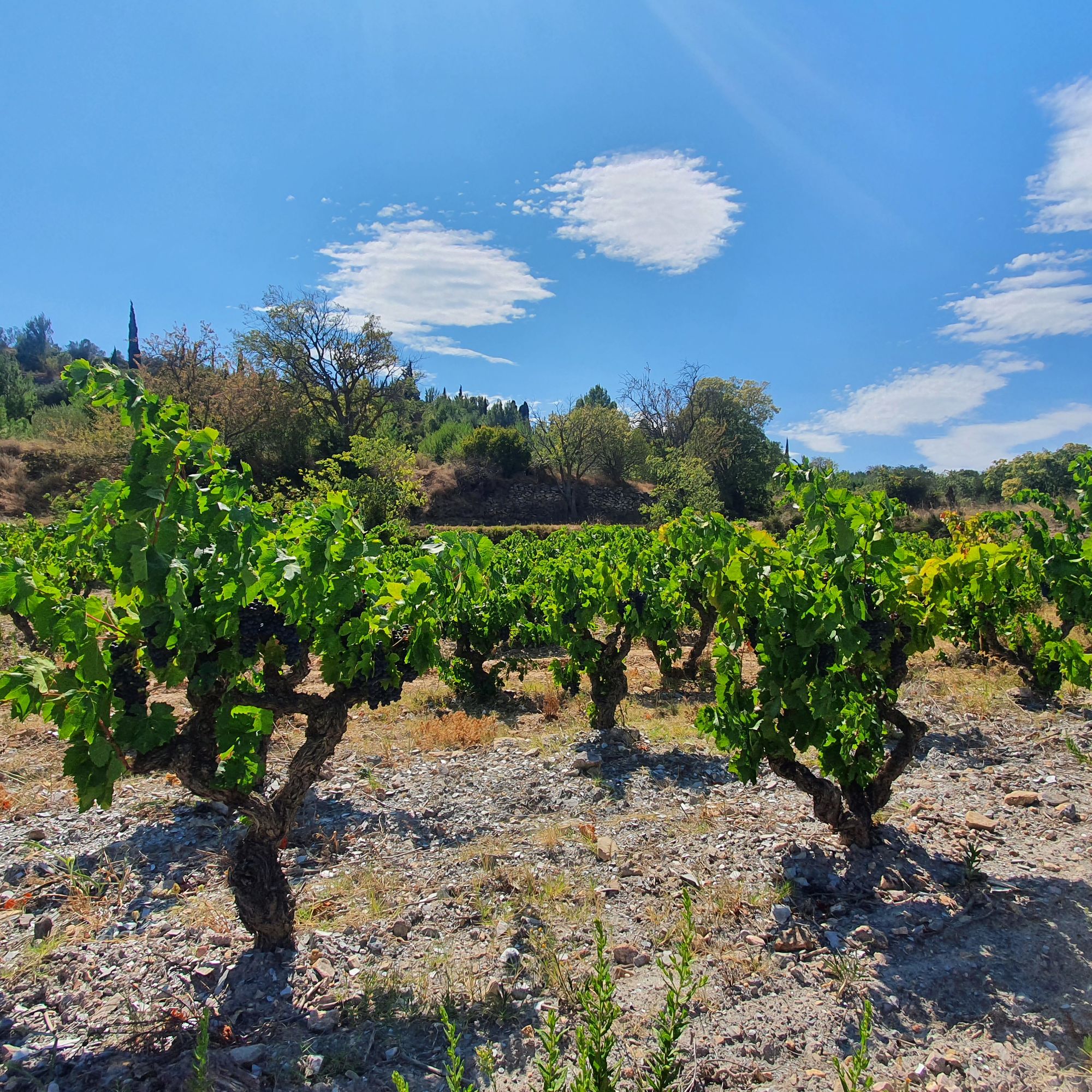
How would you describe the wine?
It's always my intention in winemaking to work with delicacy and elegance, making wines that need to be listened to in order to be understood. The aromatics aren't huge but the wine grows in structure and has a long finish. It's a little salty, light and with white fruit notes, such as peach and pear.
How does this vintage compare to others?
2022 is less salty thank other vintages, but more expressive in the fruit flavors.
When is it best enjoyed? Now or later, if people want to age it further in the bottle?
Now it will be at its best.
What’s the story behind the name of the wine, Astradyne?
In all of my wines there are two meanings. One is from my taste in music. For this wine it's a reference to an English electro group. And the other meaning is a reference to the cosmic influences on the wine. I am attentive to the influence of the moon and stars on my vines.
Any food pairings you’d recommend?
A restaurant I work with serves it with scallop carpaccio with citrus zest and Sichuan pepper, as well as tagliatelle with vegetables and coconut curry broth, which both work really well.
Isabelle's thoughts on Astradyne - This pure Macabeu by a relatively unknown producer is wonderfully restrained and earthy with a lean, slightly waxy texture and mouthfeel. It brims with grilled almonds, aniseed, pollen and a hint of toasted - almost smokey - sourdough. Showcasing green lime notes, green olives and a salty minerality, this is a wine with a lovely complexity and a pronounced sense of place.
TOTAL SULFITES: 0.2mg/L
Mingaco, Orange Muscat, Itata, Chile, 2021
Mingaco is a family winery run by Pablo, Daniela and children Luan and Mayra Pedreros in the Itata Valley, Chile. They work using regenerative agriculture and produce small batches of wine, as well as making their own preparations and teas from local plants and fungi.
Q&A with Daniela Pedreros
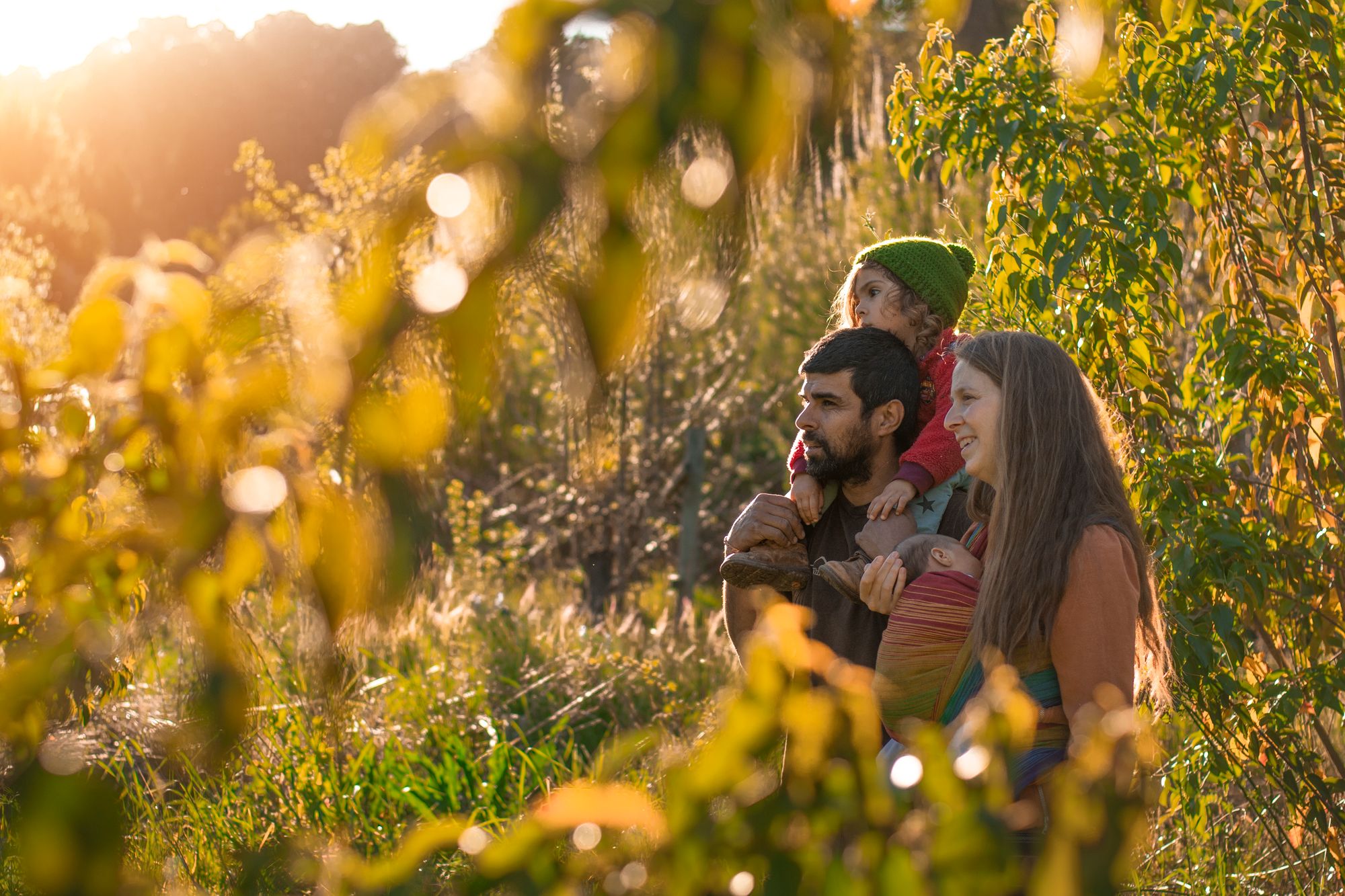
What's your background - do you or Pablo come from winemaking families, and was there anything else you considered doing before winemaking?
Pablo is from a winemaking family - his grandfather was a winemaker who learned everything he knew from the countryside where he was born and raised. Same with his father. Pablo got married, had a child and moved to the city, but became mentally unwell and decided he needed to reconnect with his roots and nature, so came back to the countryside. During that time, his father passed away, so Pablo started working all the family vineyards by himself. That's when he made the decision to not use any synthetic chemicals or herbicides in the field. Now, we also work following the biodynamic calendar when it comes to harvesting, pruning and bottling, but we are not making any of the biodynamic preparations yet.
I'm from the city. I was born in Santiago but raised in Concepción which is around an hour from where we are now, but I had never even visited the valley and didn't know anything about its ancient varieties like Pais, Cinsault or Muscat. I had no direct link or connection with wine. I studied creative arts and started travelling, moving to Australia for a year and a half. At some point I came back to Concepción and led a very normal, boring life. That lasted for a few years but I felt I needed a complete change of lifestyle. I didn't know what I wanted to do, but I knew I didn't want to be in the city anymore. I moved to the countryside, but still travelled into the city once or twice each month to lead different workshops, such as making green juices or fermenting things like sauerkraut, and Pablo attended one of them. That's how we met.
Can you tell me about Itata, and the grapes, climate, culture and traditions that define the region?
The most common grape varieties are Pais and Cinsault, but where we live, it's mostly Muscat d'Alexandria. That's the grape used for the wine that Isabelle chose for the Club and is what Pablo has been making since he was a child - it's what he knows best. The climate is Mediterranean and dry coastal. We're 26km from the Pacific ocean and we're only 300m above sea level which, in Chile, isn't that high. We have a lot of Pacific influence and in winter, a lot of influence from the Itata river which we are around 6km away from.
Itata used to be a place that produced a lot of wheat. Native trees were cut down to make room to grow more wheat, which would be exported across South America and other countries. It got to the point where the soil was all burnt out, so they changed to vines, that’s why some of the oldest vines here are around 200 years old. When wine stopped being profitable, many decided to change to pine trees and there's now a huge forestry industry. So on the one side, there's this strong agricultural culture, and on the other, the huge forestry industry.
The wine culture here came from Jesuit Christians. Near where we are there were two - what we call ‘haciendas’ - big patches of land that they owned. They brought different grape varieties over from Tenerife as it was the last stop before sailing to South America. With their knowledge of winemaking and the climate, they started planting different varieties that they thought would adapt better.
Today, we have people from the countryside who own and work vineyards, mostly selling their grapes because it's what their parents and grandparents did. But it's sad because it's not paid well - usually 10 cents per kilogram, or 20 on a good year. They don't make enough money to cover their costs, so a lot of older vineyards are disappearing and being replaced with avocado or pine trees which are more lucrative for them.
Itata valley as it exists today will come to an end I think, because the population is getting older. Young people are migrating to the city and pruning is a craft you learn by doing, normally as a child, but the people pruning here now are typically very old. Pablo's generation - people in their 40s - will have 3-4 siblings and only 1 stayed in the countryside. Often all of them left. The people here who are 20-30 years old, their parents were so focussed on getting them to study that they didn't teach them the craft of pruning, among other farming things.
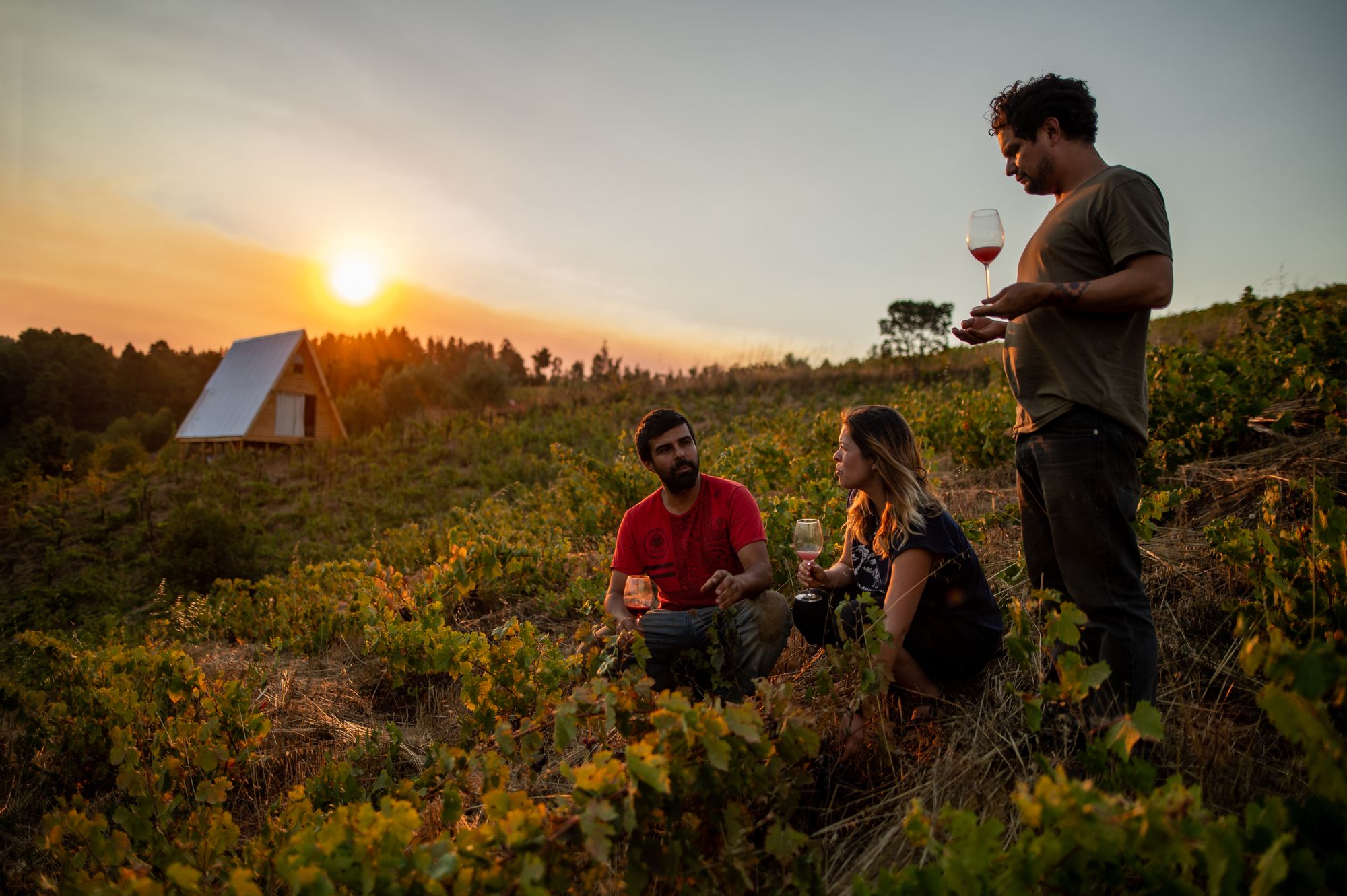
Is there much of a natural wine scene there?
When Pablo started around 13-14 years ago, he was considered the lazy grower in the neighbourhood because he was leaving his grass to grow in the vineyard. Most of the neighbours sell their grapes or wine in bulk, whereas Pablo began bottling wine from his grapes. Around 3-4 years ago, an oenologist friend of ours started asking Pablo about what he was doing, and now works using similar methods. One of our neighbours, who came from the city and whose mother is from the countryside, has started making wine using permaculture. There are also a few people from outside of Chile making natural wine in Itata too now. There's definitely not what I'd call a scene, but it's the beginning of one. We even have a natural wine fair here now, it’s called ‘Harinaos del Sur’.
Do you struggle with the wildfires where you are?
Exactly a year and 2 weeks ago, our place got completely burned, except for our wine cellar and our house. Our vineyard, fruit trees, native trees and vegetables garden all burned. It's the sad reality of where we are, and it'll keep happening because of the pine and eucaliptus plantation all around us. At the beginning we didn't know what to do about it, but we now see that we have to just keep doing what we're doing, but work harder and faster to regenerate as much soil as possible and to plant as many native plants and trees as we can. We also compost with specific microorganisms to increase diversity in the soil. In particular, we inoculate with fungus as it improves the soil vitality and helps retain humidity which, in the future, could protect against wildfires. There will be another one for certain, but hopefully not for a while.
What's the state of the vineyard now?
Pablo owns 1 hectare of vines, around 30 years old, and works on 3-4 more hectares from his family. We thought we lost all of our own vines, but in October they started sprouting so while we won't have production from these vines this year, we may do in the next couple of years. We didn't make any wine last year, because the grapes that didn't burn tasted really smoky. Currently we are making wine from the family vines, which are all Muscat. We also purchase some Cinsault and Pais grapes from a couple of growers closer to the Itata river, with more humidity and different weather to us. Pablo guides them in terms of production methods, and we pay a much better price than they usually get.
Some importers tell us our wine is expensive, but we believe that this comes from the worldwide idea of Chilean wine as a cheap wine, and also that people are used to cheaper Pais wines in particular, but it's often made in bulk. The conditions for making wine in Itata are unfavorable. From the plantation, pruning and harvesting to buying supplies or shipping the wine, every stage of the winemaking process is a challenge. For this reason, we have an agreement to pay a better price when buying grapes and be paid fairly ourselves. We live here and have invested a lot of money into our winery, so when importers say it's expensive, I say it's not expensive enough! After 7 years of Mingaco, we are still not seeing any returns.
Can you describe the soil and share more about your approach to creating biodiversity in the vineyard?
It's a clay soil with some quartz, of granitic origin. As well as the inoculation of fungi, Pablo will plant lupines the first years of working a vineyard, which contribute to the soil's nitrogen and till the soil naturally, because the root grows quite deep. Then, once you cut the lupines, they feed microorganisms into the soil. We leave herbs and grass to grow for most of the year and cut them during spring. We also apply two kinds of prep from our compost: one is a tea for the leaves and one is an extract for the soil. The idea is to apply these throughout the season, but we don't always have time, so of course we get some fungal disease from time to time. In this case, Pablo will apply a type of clay called zeolite, instead of sulfur. For 2 years, we have also done what's called 'respectful pruning' which leaves longer shoots. There’s one of our Muscat vineyards in particular that has native trees on one side and fruit trees in between. Before the wildfires, the vines started to climb through the fruit trees. Now we're adding more of the fruit trees to transform the whole vineyard into an edible forest again.
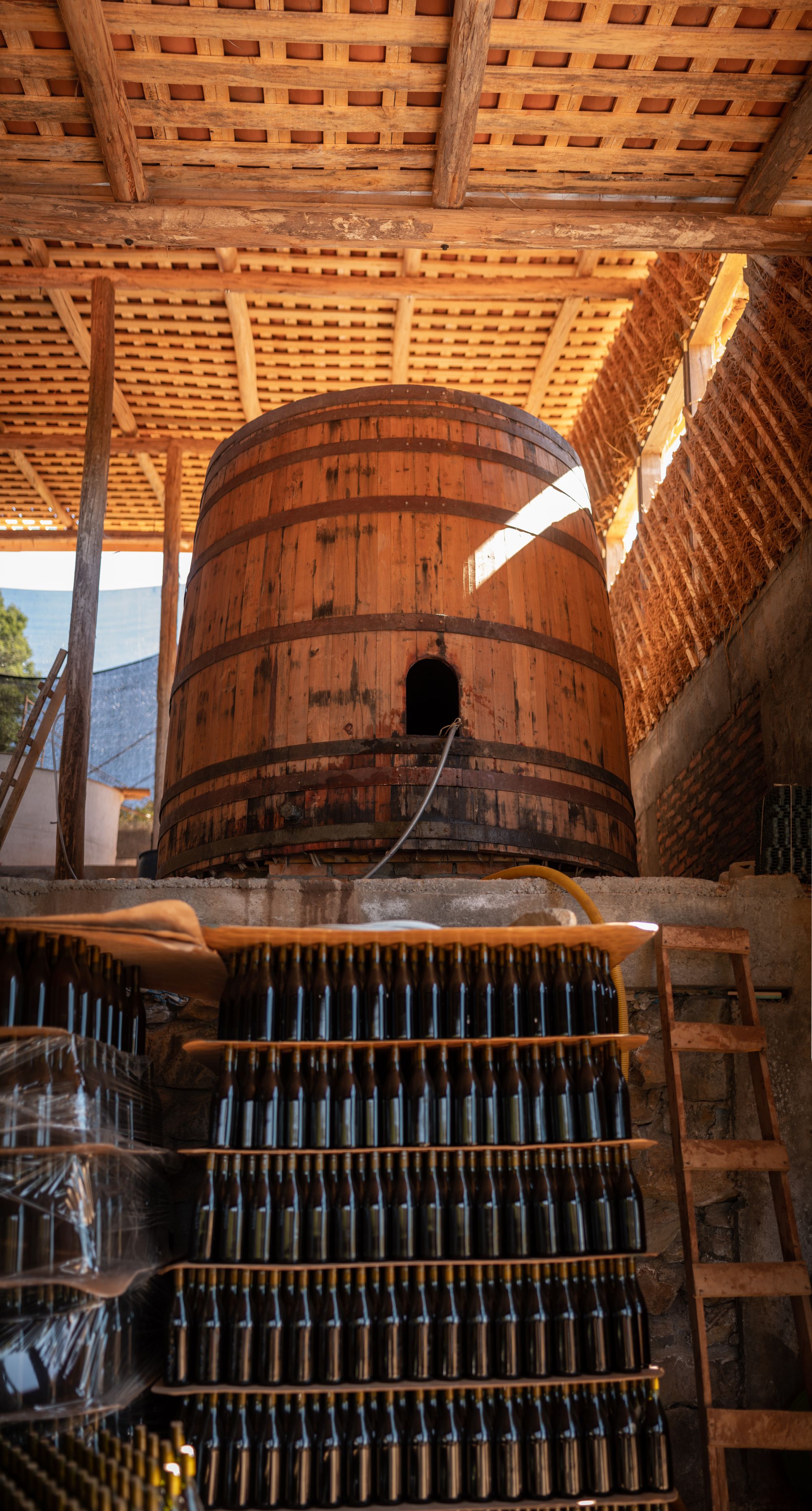
I'd love to hear about your cellar and how that's set up.
When I met Pablo, one of the things that worked well between us is that I had a lot of aspects of my life figured out, but I never visualized where or how I wanted to live. Pablo had that clear. He is really into bioconstruction [a sustainable kind of architecture that respects nature and the environment], so we built our house with this technique. At one point, it became clear that we really needed a wine cellar because we were making wine everywhere. The first space was a traditional adobe construction - which is using raw mud that's been formed into bricks - built by Pablo's father.
When we decided to make our own wine cellar, it was always going to be with bioconstruction. We contacted one of the only architectural firms we knew that worked in this way. They decided to design it with adobe again, but Pablo didn't want to do this as it takes a lot of time and space. We decided on something called quincha, which is where you build wall frames using wood, and fill the frames using dry straw with a little mud and water. It's a great insulator for both temperature and sound. Once it's dry, you cover it with a mixture of mud with just a little straw, so the opposite of the filling. It's like a mud construction, made of earth. It has three levels, to work with gravity: the top level is for fermentation; the middle for ageing; and the ground floor is where we bottle.
What does Mingaco refer to in the name of the winery?
Mingaco is a word from the indigenous quechua language - it refers to the practice of asking someone for help and promising something in return. For example, when Pablo's father needed to cut his wheat, he'd call over his family, friends and neighbours and everyone would work together, have a big meal and take some wheat home with them in return. Our neighbours do this with their potato harvest, so we help with that and take some potatoes home with us, and we do it too for fruit picking and bottling, and offer grapes or wine in return.
Can you talk me through the process of making this wine?
Pablo is the one who makes the wine - I work on all our communications. So if you asked him, he'd say that this wine was made as it was made 200 years ago. In Itata, the white wines are made like reds, with skins. This one was macerated with 12 days of skin contact in an open cellar, like a swimming pool, and outside to allow interaction with native trees and yeasts. After that, it was transferred into three different containers as we didn't have enough of one, so a third went into colonial, 100-year old amphoras, another third went into used oak barrels and the final third went into plastic tanks and developed a veil of flor on top. We harvested in March and bottled the following March, so it gets exactly a year.
Do you use any sulfites and what are the total sulfites per liter?
We don't use sulfites in the vineyard, but we burn some sulfur in the oak barrels when they're empty and sometimes during the last days of fermentation. We never add any at bottling. This wine has 1mg/L.
How would you describe the wine?
It's unique - like an artwork that nature gives us. There's no temperature control or yeast selection, we don't add anything. The wine speaks for itself.
How does this vintage compare to others?
It's Pablo's favorite vintage so far, maybe because of the combination of amphora, oak and plastic with flor. It has great acidity and is a very complex wine. For the last two months, it's been drinking at its best. We only have 200 bottles left here and Pablo's not selling them, just drinking or sharing them with friends.
Do you think it's best that people open it now in that case?
Right now, it's amazing. It's hard for us to say how it will age because in Itata, we don't have Muscats that are 10 or more years old, like in Austria or other places (as wine was made and sold bulk, drunk during the same year and never bottled). If you have the opportunity to get a handful, I'd suggest opening one now and laying a couple down to see how it evolves, but otherwise, I'd say to drink it now.
Any food pairings you’d recommend?
It's always good with fish and seafood, or even white meat. It also works well with pasta dishes that have a white sauce.
Isabelle's thoughts on Muscat - A beautifully honeyed, spicy curcuma, macerated Muscat, full of white flower notes, fragrant yellow peach and crunchy apricot. Expect some tannins, a tense, mouth-watering acidity and a savouriness that helps tame the intensity of the Muscat. There is also a touch of bitterness of the sort you get when you suck on a peach stone. The result is a wine of great balance - an accomplished skin-contact wine. Chile’s natural wines really are vastly underrated.
TOTAL SULFITES: 1mg/L
Domaine des Hauts Baigneux, Les Moulins, Red, Loire, France, 2021
Domaine des Hauts Baigneux is a negociant winery run by Nicolas Grosbois and Philippe Mesnier in France's Loire Valley. They originally purchased 12 hectares of vines in the Loire's Azay-le-Rideau appellation, but after a destructive frost in 2016, pivoted to become a negociant cellar, buying grapes from south and southwest France to make wine back in their cellar.
Q&A with Philippe Mesnier
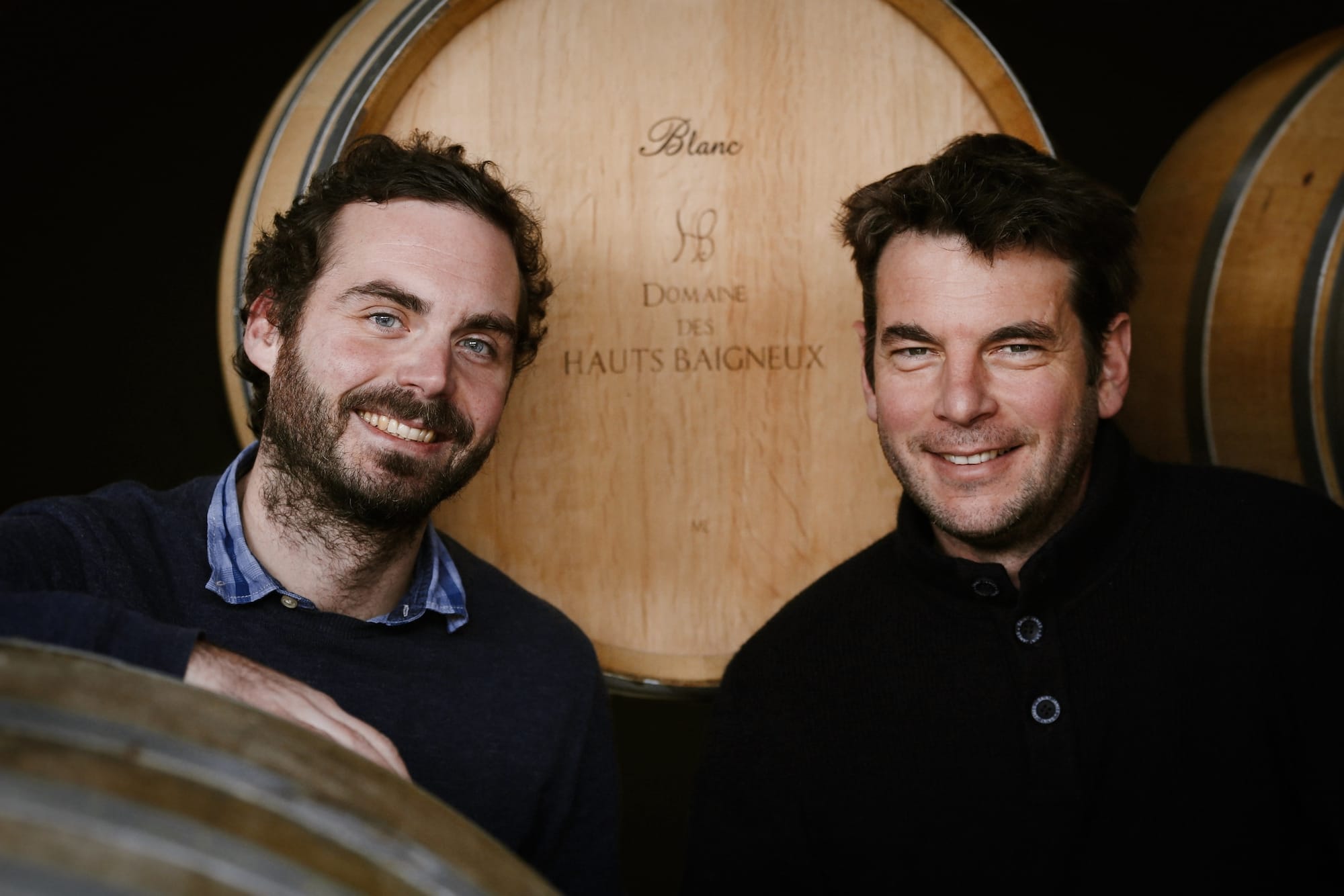
Can you tell me about your background and how Domaine des Hauts Baigneux came about?
My parent's house is surrounded by vines, but not our own. Wine was always part of my culture though - my parents like good wine and cooking. We had rabbits and chicken in the yard. But my grandfather was a baker and had his own vines, which he used to make his own wine from. He also made spirits and grappa. I had the chance to taste my grandfather's wine from 1947 when I was 8 or 10 years old!
The Domaine is a story of land, terroir and friendship. I come from the Loire Valley in the Vouvray appellation. I was interested in making wine and Nicolas and I had been good friends for a while. In 2012, we decided to purchase our land in the Azay-le-Rideau appellation, because some of its best terroirs had not yet been taken. It was the perfect place for us to set up our estate and do everything organically and biodynamically. We also planted our own fruit trees here in the vineyard.
Nicolas of course is more of a specialist, because he grew up producing fruits and taking care of the vines at his family estate, Domaine Grosbois [also in the Loire]. He's the master of the vines and I play my part from harvesting through to bottling. But we make every decision together - from beginning to end. He's also my son's godfather, so it's not just a professional relationship, but a friendship, too.
I read that you have 12 hectares of your own vines, but also purchase grapes from across France. Can you tell me about how you work with growers and what you look for when seeking grapes for your wines?
We've been buying organic grapes from other growers since the beginning, not out of necessity, but out of choice. We wanted to be able to blend using different grapes to create something we'd never tasted before. When you have your own vines, it's usually a case of making wines block of vines by block, but when you bring in fruit from different terroirs, you can find a new balance. We purchase 4-5 different grape varieties from the south east, south west and the Loire. All organic, most biodynamic. For us, that's the only way to do it.
It's also about developing a relationship with the grower and getting closer and closer, so that we can be as precise as we want to be in the growing as we are with our own land and with our blending. You have to understand the grower you're working with and understand the grapes you're buying. You have to eat the fruit to analyse it - sitting at a computer won't tell you what just eating the grapes can do. When you eat the fruit, you can taste the acidity, the concentration and the aromatics, and decide when to harvest to create optimal balance. You have more power to decide what the wine will be like. What's also exciting is that each vintage is always different. Our experience helps, but you can't just repeat the same recipe every year, it doesn't work like that.
Of course we still produce single block wines from what we grow in the Azay-le-Rideau appellation, but the blends are our signature wines - and we share the same passion for both.
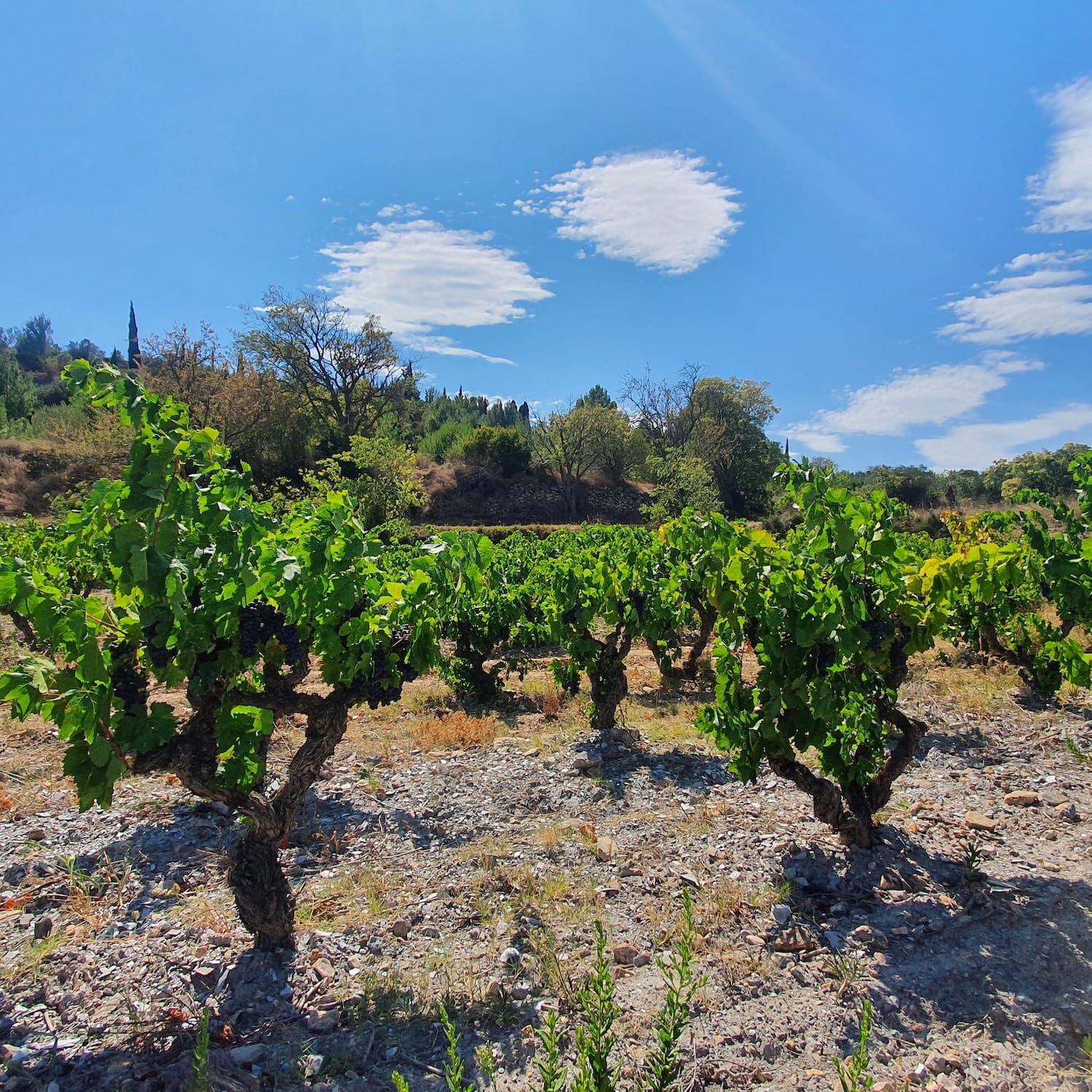
What grapes have you used for Les Moulins Red VDF and where do they come from?
It's 100% Cabernet Franc and a blend of purchased grapes from the south west and our own grapes from the Loire. The south west grapes grow in limestone and clay soil. The limestone gives an austerity to the sunny region. You have some spicyness but also the minerality we're looking for. Our own grapes are grown in clay and flint soils. The flint gives a sharpness and saltiness, with some minerality.
We do the vinification separately, because we think it's better for the children to grow up separately, with their own education, then come together as a family. Otherwise, you will not get the benefit of each terroir.
Can you talk me through the process of making this wine?
The south west Cabernet Franc was harvested on 16th September and ours on 6th October, which is late compared to what's typical.
The south west grapes were macerated for 4 days, then destemmed. Because it's already concentrated, we don't have to extract the fruit and only take the natural concentration. We don't need the extra strength or tannins, as we want to keep some of the lightness and fruitiness. For the fermentation, we only use indigenous yeasts and everything was dry by around 20th October, which is quite fast. With late vintages, you don't have much sugar for the yeast to eat, so it happens much quicker.
The Loire grapes were macerated for 5 days in the same way, with no pigeage and no extraction. We aged them separately for 3 months, then blended in early 2022, before bottling in May. Everything is done in stainless steel. For around a month after bottling, the wine is a little closed so we don't release it until after this. Now, it's perfectly open and very elegant.
Do you use any sulfites and what are the total sulfites per liter?
We add a small amount of sulfites 3 months before bottling, because we want to keep the fruitiness and elegance of the wine. We want it to be a Cabernet Franc that ages for years in the bottle and can cross the Atlantic and be enjoyed in the US and in Canada, and in the UK. That's the beauty of wine. And because we do it 3 months before bottling, you don't taste the sulfur at all, which you might if we were to do it it just before bottling.
How would you describe the wine?
It's fruity with cherry and blackberry notes, and has some complex spiciness. Freshness and minerality are given by the limestone and flint, and it also has a long salty, sapid finish. It's easy to drink, but also elegant enough to pair with good food. It's not too full bodied. it's elegant or light.
How does this vintage compare to others?
We call it a cold vintage or a late vintage, as we had to wait for good concentration and maturity which is unusual. Most of the time we have early vintages harvested around early to mid September. But 2021 it was not like that, so it's more comparable to vintages we had in the early 2000s.
When is it best enjoyed? Now or later, if people want to age it further in the bottle?
You can drink it now, but you can also age it for a few more years if you wish.
What’s the story behind the name of the wine, Les Moulins (the windmills)?
That is the name of the block in the Loire where it comes from.
Any food pairings you’d recommend?
It pairs well with meat or fish. For example, duck or fish with a fennel sauce and some red fruit. Dishes with a little spice also work well with the spiciness of the wine. For vegetables, roasted fennel, zucchini or broccoli.
Isabelle's thoughts on Les Moulins - A perfectly mature, textbook expression of a Cabernet Franc with a twist, as the blend includes grapes from the cool Loire as well as the warmer French southwest. Expect a mix of aromas, including cool climate notes of tangy blackcurrant, crunchy capsicum, cassis leaf, graphite and hints of eucalyptus, that marry up with notes of sunnier climes including ripe mulberry and licorice root. Soft, well integrated tannins.
TOTAL SULFITES: 20mg/L.
Viñedos Herrera Alvarado, 'Rojo Loco' Red Pais & Cristal, Marga Marga, Chile, 2021
Viñedos Herrera Alvarado is a winery in Chile's Marga Marga province in the region of Valparaíso, run by Carolina Alvarado and Arturo Herrera. They work 2 hectares of biodynamic grapes that haven't been irrigated for many years, is just 15km from the Pacific Ocean and surrounded by forests. Another wine of theirs, Cuero de Vaca, was included in the RAW WINE Club selection for March 2023.
Q&A with Arturo Herrera
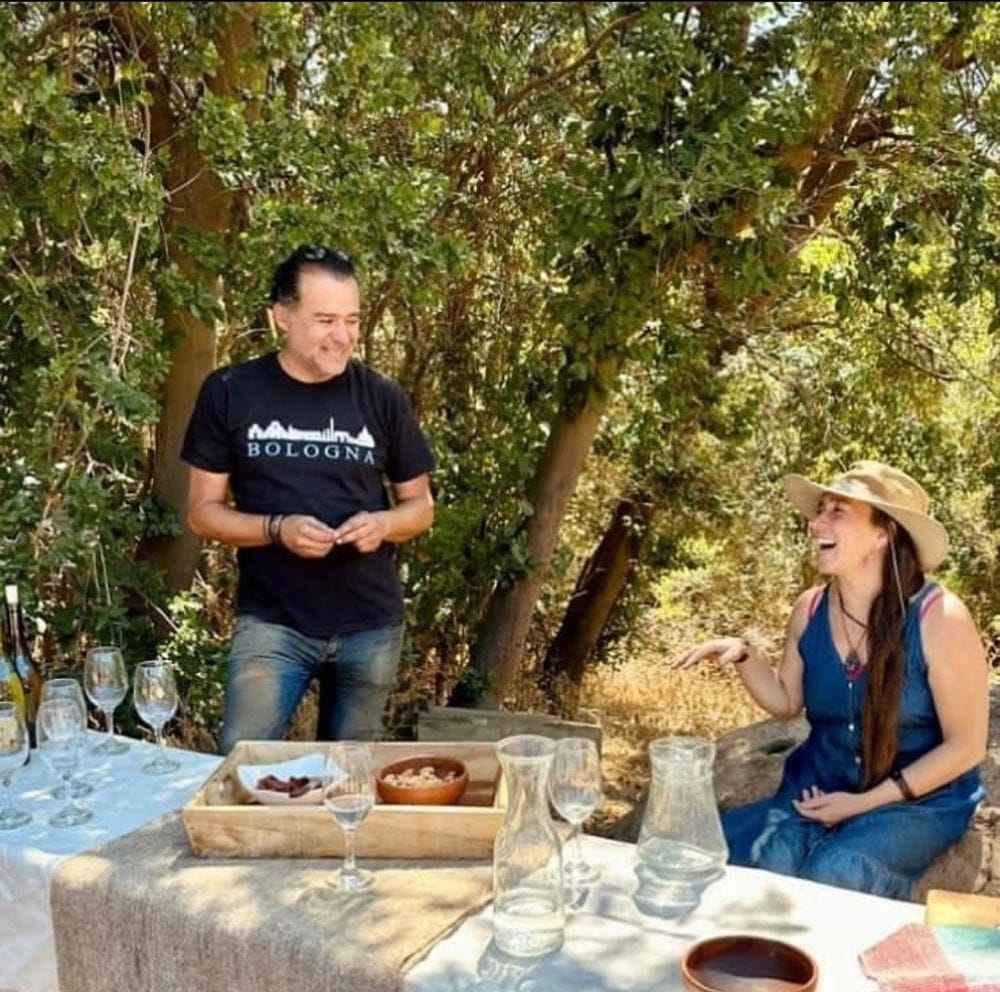
We are very happy to share another of your wines with the Club. For those of our members who are not yet familiar with Viñedos Herrera Alvarado, can you tell me about your background and how you became winemakers?
Where we’re based used to have a lot more wineries, but over the years, local traditions were lost. When we decided to make wine, we wanted to learn from the old winemakers, about how they made wines with indigenous varieties some hundred, two hundred years ago. These wines were always made in harmony with nature, the environment and its people using techniques passed down from generation to generation. It’s what we now call natural wine, but it was just wine that was made to be shared with family and friends on weekends.
We’ve always lived in the area and have been making wine in the same way for 20 years. We didn’t want to use modern, violent oenology and the life that comes with it. We chose to use the techniques of our grandparents who made wine in their houses, surrounded by vineyards. We want to work in a way that takes care of nature and our community at the same time, and maintains local traditions. We make wine for everyone and share it with friends who, in turn, share their ideas and recipes. Everyone contributes to the community in different ways.
At first, we rented a vineyard. Then we were able to buy an abandoned 60-year-old plot that had been planted with French strains and that we then planted with some Spanish strains. We work regeneratively and have also planted native grape varieties like Cristal, a strain that adapts really well to our soil, Pink Muscatel and Alexandria. All these strains are more resistant to drought and more generous in their production.
Has the Chilean natural wine scene evolved since you started?
It has evolved quite a bit. Both producers and consumers are more open to trying this kind of wine. Consumers ask for and seek them out, especially young people. There’s a growing trend for natural wine, so producers try it, make mistakes, learn and then start wanting to make wine without intervention. It’s good to see wine production continue to evolve in a way that serves the environment. It’s not something that should remain just a trend - it has to be taken up with an understanding of how one wants to live! There’s now a dialogue that didn’t previously exist, with producers talking about how to protect their soil and their grapes, to produce something from their own environment.
But with industry pressures, it’s not easy for young producers to start their own path. You have to have courage and call on great inner strength. The best reward for us is when we’re able to convince people to make natural wine after they finish their studies, through inviting them to work in the vineyard, doing harvests and presses. That’s the best learning we can offer and we are interested in continuing to share this with people.
Can you tell me about Marga Marga, the grapes, the climate, and the traditions that define the region?
Marga Marga is very old. There are records from 1586 that indicate the presence of both gold and vines in this area, brought over by the Spanish in the native language, Marga Marga means Gold Gold. So there have been grapes here for over 400 years, and also an influence from French winemakers who gradually replaced the Spanish strains - which wasn’t the best idea.
The area has a strong sea influence and a very favorable climate, especially for white grape varieties. The soil is predominantly clay and we are surrounded by a very important sclerophyllous native forest, which is always green and requires little water to thrive. It is full of fauna, flora and biodiversity. There is a lot of surrounding life that contributes to the health of the vineyard and that allows it to remain in balance without the need for intervention.
Have you been affected by the recent forest fires?
The fires were very serious in terms of loss of life and homes. It necessitates a tremendous commitment to regenerate the biodiversity, flora and fauna of the land, and part of how we do this is through planting native grapes. We were able to control the fires here where we are, but native forests and surrounding life is lost which means our support work with the wider ecology is compromised. Not far away, there was a beautiful botanical garden which was completely burned. We lost around 4,000 hectares in total in the area.
The law here in Chile doesn’t protect the land because when forests burn, it creates space for new buildings. Sometimes it seems as though the fires are intentional. This time was a catastrophe with 150 deaths, not counting all those who were affected with burns and lost everything. We have to help each other. As for our winery, the temperatures and smoke from the fires were challenging, but we were okay.
What are some of the traditional ways in which you work?
Our winery is made of local clay - there is no cement or concrete in its construction. We don’t have electricity or temperature control, and we use old techniques. These include a bamboo mat used to destem and crush grapes, vats made from cowhide and rauli barrels made from old Chilean wood - but we also use old French barrels.
Can you describe the vineyard and its surroundings?
We’re not far from the sea to the west and the Andes mountains to the east. We’re like an island surrounded by green hills and forests. The climate is very healthy. We also have a volcanic influence and a lot of purity because we have moisture in the morning, heat during the day and freshness in the afternoon. The sea, the mountains, the volcanoes and the rivers of the area are what make our wines unique.
What grapes do you grow?
We work with Creole strains - Pais, Muscatel, Pink muscatel, San Francisco and Cuyana - and also French strains that were in this area before - like Chardonnay, Sauvignon Blanc and Pinot Noir. More and more, we replace the very delicate French strains with strains that adapt better and need less rain.
Can you describe the soil and terroir?
The soil is clay 'maicillo' (fine stone) with a lot of grass and native flowers that grow and die in the same place. It shows in the wine if we compare it with others. We do tastings and you can smell the scents, aromas, and flavors of the vineyard, the winery and its yeasts. You can smell things from the native forest!
What grapes have you used for this wine in particular?
The Rojo Loco grapes are from century-old strains, especially Pais and Cristal. We also added Yellow Muscatel, all in smaller quantities. These grapes in particular come from a 200-year-old vineyard. We work with growers to try to take care of these strains and produce a small quantity of local wines.
All the grapes are destemmed and fermented together in the cowhide vat. Once we bottle the wine, some of it is shared with the growers and some of it is sold. A friend of ours from Santiago recently suggested sending our best wine to enter into a contest judged by an important critic. We’re not usually contest people, but we sent this - our ‘neighbourhood wine’ and he loved it. The wine appeared in a magazine where he said people had to taste this exceptional wine. That’s when we decided to call it ‘Rojo Loco’!

Can you talk me through the winemaking process?
Because of it being a ‘community wine’, we mix differing quantities of grapes every year, depending on production. Its color is always the same - a light red or a very intense rosé. Then it’s pressed vertically, crushed, fermented for around 15 days in cowhide and stored in a cement tank. It ages for a year, depending on temperature.
Do you use sulfites?
No - none at all.
How would you describe the wine?
It is a dry wine, very aromatic and with a freshness that makes you happy. It is not a complex wine - it’s a wine to simply enjoy. It has a very rich, beautiful acidity and minerality. The country gives it a nice rusticity. It’s a wine of conversation that you can enjoy on its own.
How does this vintage compare to others?
The harvests are very similar in taste and aroma. Spanish strains are very stable and withstand heat well, so there is good regularity in the characteristics of the wine.
When is best to enjoy it? Now or later if people want to age it more in the bottle?
To explain simply: year one, very good; year two, ideal (the vintage you have!); year three, the maximum length of ageing that we recommend; year four, it will start losing its characteristics.
Any food pairing recommendations?
It doesn't need anything - but it works well with desserts, fresh cheeses or other soft foods.
Isabelle's thoughts on Rojo Loco - This ‘Crazy Red’ is quite unusual for being a field blend of País and the rare Cristal grape (I personally like to drink it slightly chilled). Peppery, with flowery notes of violets and poppies, it has the thirst-quenching quality of pomegranate juice. Featuring light but grippy tannins, Rojo Loco is incredibly moreish and has a brightness of aromas which I think is - in part - due to the fermentation in cowhide. This method of winemaking is centuries old but also very rare today, and Carolina and Arturo are heroes for keeping it going. It isn’t a gimmick for them - most of their wines are made this way, which is extraordinary in and of itself given the precision (and hygiene) required to achieve wines of this caliber and finesse. They are exceptional winemakers, and are very possibly the first Chileans to have knowingly made natural wine (in the modern era) back in 2003.
TOTAL SULFITES: <10mg/L
La Zafra, 'Nu Tinto' Red Monastrell, Alicante, Spain, 2019
La Zafra is a winery run by Mar Cabanes and Ignacio Mancebo in the high altitude village of Monòver, within the Valencia region of Alicante, Spain. The couple returned to the area in 2016, where Mar's family had grown and sold Monastrell for a number of years. They purchased vines from Mar's uncle and established their own winery, producing wines that are fresher than the area's typical style.
Q&A with Ignacio Mancebo
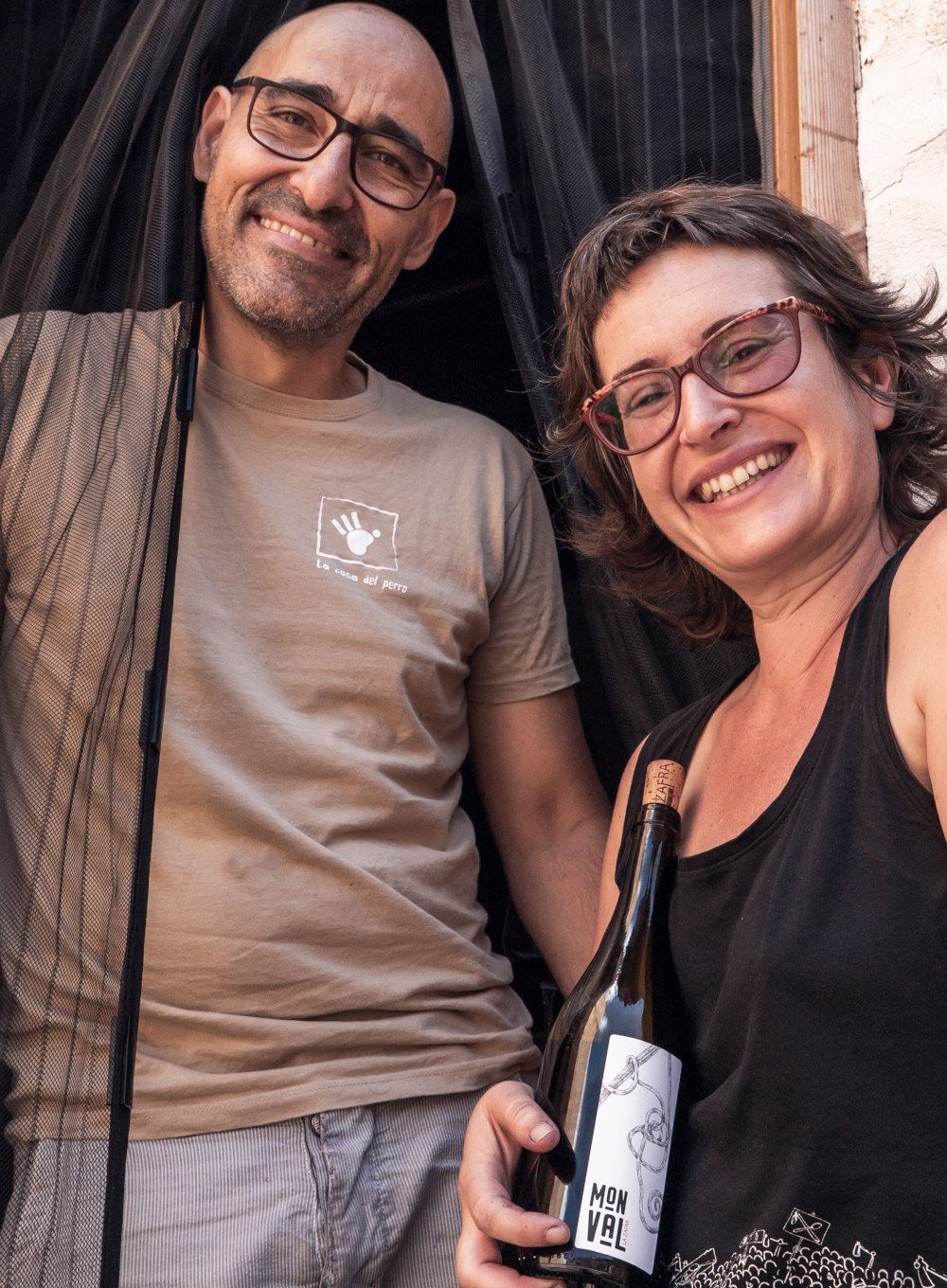
Can you tell me about your background - what you did before making wine, how you met Mar and her background too?
We met about 13 years ago working in Ciudad Real, a city in La Mancha. We worked in territorial development and agroecological projects. Just before we met, Mar's father passed away and she inherited this plot in Monòver. We decided to return to her home and put into practice what we had learned as agroecological technicians.
How has your background in agriculture influenced your farming and winemaking methods?
Because of our backgrounds, we were sure about the way we wanted to work from the very beginning - always organic, which we now have the certification for. We didn't know anything about wine. Mar's family had been making wine for themselves, but making wine professionally is very different. We were sure that, because we were farming using organic methods, we wanted to make wine with the same philosophy. So we started making natural wine before we knew what it really was, and discovered later that this is what we were doing. It just came naturally to us.
Can you tell me about Valencia, and the grapes, climate and traditions that define the region?
We are in the south. It's a traditional winemaking region, with vineyards, almonds and olive trees. It's traditionally not irrigated and has very dry soils. It's hot, not as hot as La Mancha or other areas of Spain, but hot. Fortunately, traditions are being recovered here - it used to be mostly cooperatives and industrial winemaking, but now we have more and more wineries where the same people who grow the plants are making the wine.
Are your wines different to the typical wines of Valencia?
Yes, and for several reasons. We take a lot of care with the soil, as healthy soil gives healthy plants, healthy plants give healthy grapes, and healthy grapes give good wine. Another reason is that we take a lot of care deciding when to harvest. It's typical here to harvest later for higher alcohol, but we don't seek this - we seek quality. So we harvest earlier, but we also harvest different plots on different days, depending on ripeness. Sometimes even harvesting on different days within the same plot.
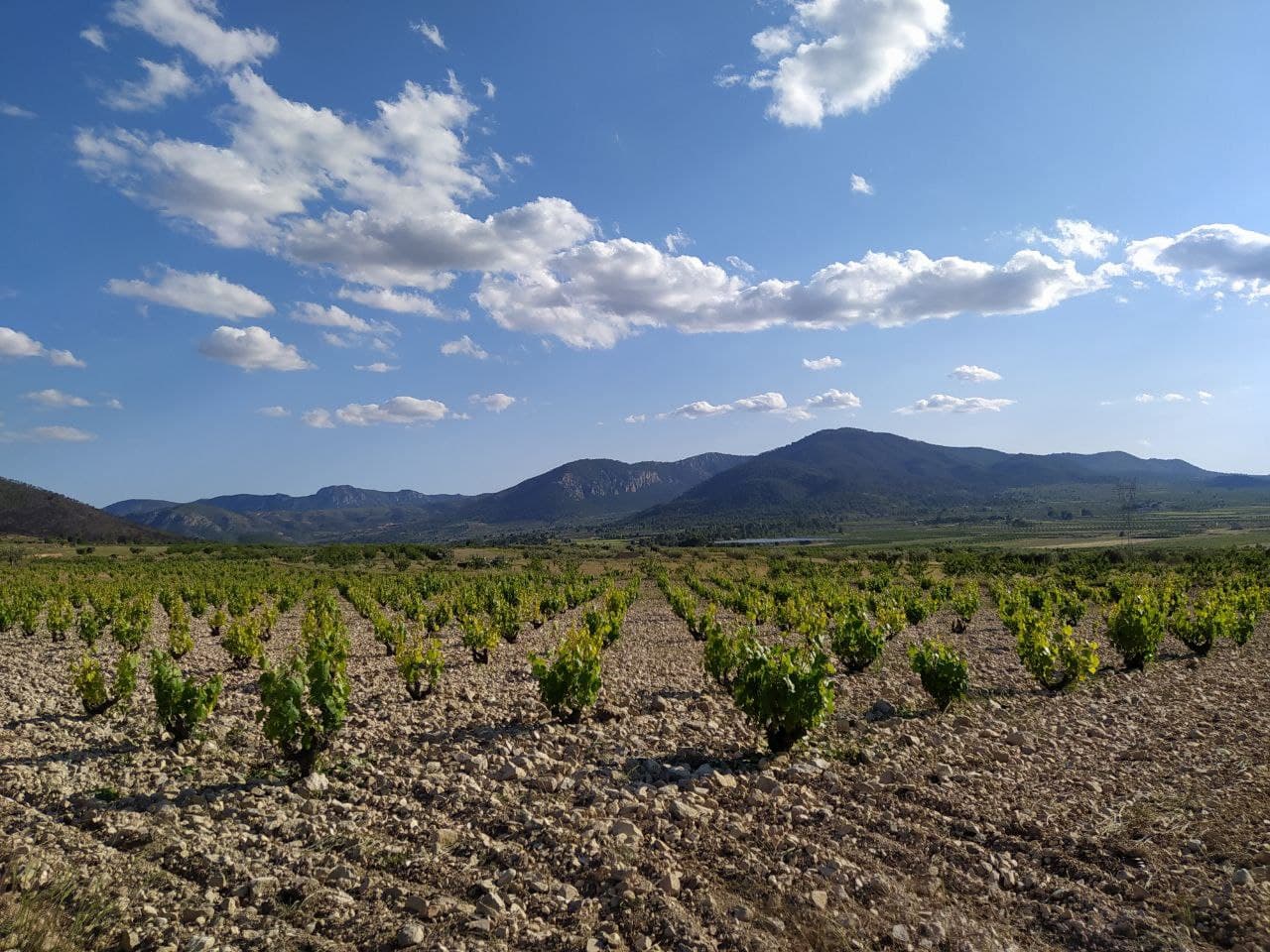
Can you describe the vineyard and its surroundings?
Our vineyard sits just above where the mountain meets the valley. All the vineyards are pretty close to the mountain of La Zafra, a very beautiful mountain made of stone and with caves. That's what we named our winery after. It's a great place for growing healthy grapes and making wine. It's very dry but it's easy to achieve a good quality grape.
What grapes go you grow and how many hectares do you work with?
We have 7 hectares but in production we have 5 or so. I'm currently very busy with planting new vines. Mainly we work with traditional varieties. The most important is Monastrell, an ancestral variety that's on 25 or so year old vines. It's very well adapted to our climate and our soils, and it needs a long time to grow the grapes so harvest is later than almost all other varieties. It's traditionally used for full bodied wines with high alcohol content. For white wines we work with Messeguera, a traditional Mediterranean grape that you find from Catalonia to Murcia. Ours are approximately 85 years old with low yield, but very high quality. Another variety we work with is Alicante-Bouchet, also known as Garnacha Tintorera. We recently began working with this grape, it's not as traditional as the others, but it's been here since around 1856.
We also work with a variety called Valencí Negre - there's only one remaining plot of this variety in the world, and that's the one we work with. Elspeth, an English woman who came here in the 1980s bought a house that has a plot with this variety. After Spain joined the European Union, it became illegal to make wine with this variety, so a lot of farmers removed their vines. Now it's legal again, and the owner decided the keep them. They are now more than 80 years old. It's a plot of around 3,000 square meters. They're beautiful grapes that produce very beautiful wines. We're planting a plot of this grape too, so that we can help to recover the variety.
What soil do you have?
We have different soils. Closer to the mountain we have poorer soils with a lot of stone. The mother stone is calcareous and it gives us soils with a high pH. they are poor soils. Closer to the valley, the soils become heavier with more clay, but richer in nutrients. We have poorer soils higher up and richer, heavier soils lower down.

Which grapes have you used for this wine?
This is Monastrell. All our wines, except for one, are monovarietals. This is because we think it's the best way to express the grape, the soil, the climate and the year. This one is in the higher soil, with less depth and more sand and stone. It makes the wine fresh.
Can you talk me through the process of making this wine?
This wine was harvested in the third week of September 2019. We harvest manually in little boxes. We are very slow because we select the grapes in the plot, not in the winery. We look for the best grapes very carefully and only the perfect grapes go into the boxes. Each day we harvest, we make the wine within the same day. This one had 10-12 days of maceration, before manual press and 18 days of spontaneous fermentation without the skins - all in stainless steel. We don't look for high extraction because it gives us fresher, easier to drink wines. We bottle around June, July, August time. Our wines always need a lot of time to age, so it had 2 years in the bottle before being released. We don't add any sulfites.
How would you describe the wine?
Nu Tinto is the wine we make the most of and we always say that, if you drink this wine, you can experience our landscape. For me it's like being at home - you have the aromatic plants, rosemary and thyme, and you can notice the calcareous stone and the heat of the climate.
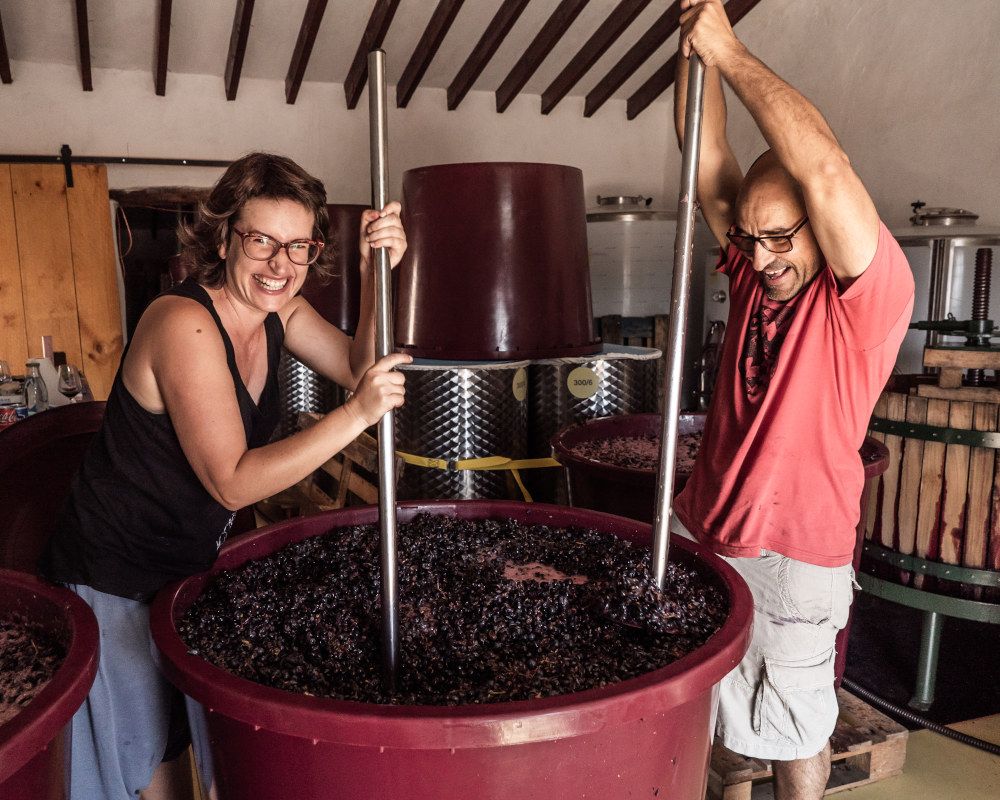
How does this vintage compare to others?
This vintage was typical. It always depends on rainfall - how much and when it rains. 2019 was normal in that sense, if we can say normal with climate change. It rained a decent amount on 1st September, so the grapes reached maturity without any problems and without high alcohol content. We have other vintages where it hasn't rained in September and they're very different wines. In 2018, it rained a lot so that vintage has a very different profile.
When is it best enjoyed? Now or later, if people want to age it further in the bottle?
Because of space, we unfortunately don't get to keep the wines here in the winery for as long as we'd like, but we always say that our wine gets better with age. About 4-5 years from bottling is perfect - which is where the 2019 is now.
Any food pairings you’d recommend?
It works with traditional gastronomy such as paella. But the paella here is pretty different to what's popular. In Valencia, we have mountainous countryside, so our paella is made with with rabbit, snails and rosemary. It also goes well with winter dishes, meat in general and fatty foods. That said, it's fresh enough to pair with lighter dishes as well.
Isabelle's thoughts on Nu Tinto - A rich, jet-black wine full of winter spice - this is our biggest wine of the line-up by far. We’re in the sun-drenched, Spanish southeast, where the sun bakes, and the earth is dry and parched - perfect growing conditions for the thick-skinned Monastrell (aka Mourvèdre), an earthy, rustic variety that ages wonderfully. Featuring notes of clove, cinnamon and dark, ripe (almost jammy), black cherry, there is also a subtle mintiness that sits alongside prominent, silky tannins. A touch anchovy and tapenade in flavor, the wine has started to develop some leather notes as well, characteristic of Mourvèdre with a bit of bottle age. A winter warmer of a wine.
TOTAL SULFITES: <10 mg/L


